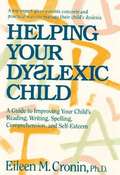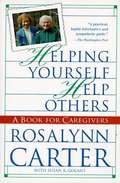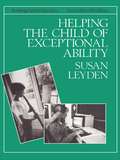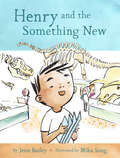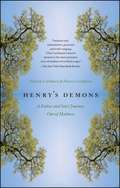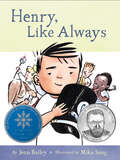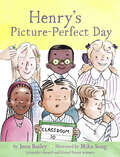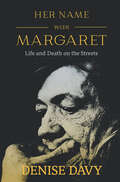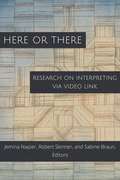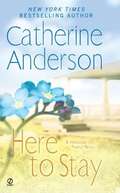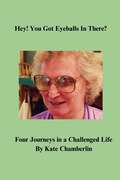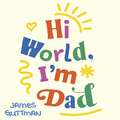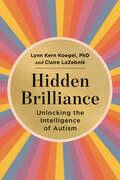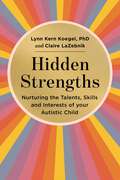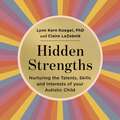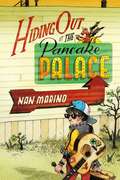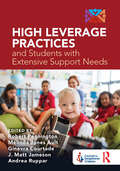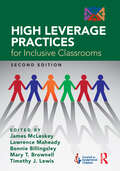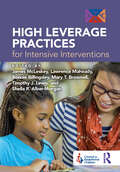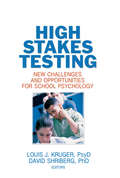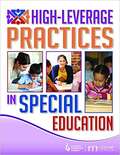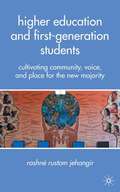- Table View
- List View
Helping Your Dyslexic Child: A Guide to Improving Your Child's Reading, Writing, Spelling, Comprehension, and Self-Esteem
by Eileen CroninCronin gives parents very clear descriptions of the behaviors which generally accompany the different presentations of dyslexia. Then, she outlines straightforward steps for capitalizing on the child's abilities A sensible and informative approach to coping with this set of learning challenges..
Helping Yourself Help Others: A Book for Caregivers
by Susan K. Golant Rosalynn CarterHaving cared at home for her ailing father and grandfather, Rosalynn Carter's involvement has taught her that Americans are in the middle of a caregiving crisis. In this book, Mrs. Carter addresses the social issues that have created this crisis and offers practical solutions to the problems caregivers typically experience, such as isolation, burnout, anger, and helplessness.
Helping the Child with Exceptional Ability (Special Education Ser.)
by Susan LeydenFirst Published in 1985. Routledge is an imprint of Taylor & Francis, an informa company.
Henry and the Something New: Book 2
by Jenn Bailey"Relatable characters, familiar scenarios, and gentle humor make this a remarkably satisfying read." —Horn Book Magazine, Starred Review From the creators of the Schneider Award-winning books A Friend for Henry and Henry, Like Always comes a delightful beginning chapter book about embracing new experiences, starring a sweet and sensitive child on the autism spectrum.It’s Field Trip Day! Henry's class is excited to visit the museum, but Henry is not so sure. The museum means maybe seeing dinosaurs, Henry's favorite. But it also means a lot of things that are new: a noisy school bus ride, a building full of echoes and hallways, and plenty of chances to get lost! Will he find something that makes all of this new worth the trip? Come along with Henry in this funny, bighearted tale about trying new things, exploring new places, and finding the courage to make yourself heard.JUST RIGHT FOR BEGINNING READERS: With short chapters and simple text, this book is perfect for newly independent readers who are just moving on to longer books.FIRST FIELD TRIP: This story will encourage and reassure any child beginning school or preparing to embark on their first field trip as Henry navigates the excitement (and potential anxiety) that comes with doing new things for the first time.GREAT BACK-TO-SCHOOL READ: Perfect for any reader starting a new school year, the Henry series explores common school experiences in a gentle, funny, and encouraging way. DIVERSE STORIES: Centering neurodivergent kids is vital to expanding diverse representation across books for all ages. The Henry series provides a mirror and a window for kids on the autism spectrum and their friends to see themselves in the stories they read.AN AWARD-WINNING TEAM: Jenn Bailey and Mika Song received a Schneider Family Book Honor Award for their picture book A Friend for Henry. See how the story continues in this classic-feeling early reader series based on the same character!Perfect for:Newly independent readersAn excellent resource for parents of kids on the spectrumLibrarians, teachers, and booksellers looking for a children’s book that offers a window into the experience of autismA reassuring read for kids with varying levels of social anxietyGift givers looking for a sweet and relatable book about trying new things
Henry's Demons: Living with Schizophrenia, A Father and Son's Story
by Patrick Cockburn Henry CockburnOn a cold February day two months after his twentieth birthday, Henry Cockburn waded into the Newhaven estuary outside Brighton, England, and nearly drowned. Voices, he said, had urged him to do it. Nearly halfway around the world in Afghanistan, journalist Patrick Cockburn learned from his wife, Jan, that his son had suffered a breakdown and had been admitted to a hospital. Ten days later, Henry was diagnosed with schizophrenia. Narrated by both Patrick and Henry, this is the extraordinary story of the eight years since Henry's descent into schizophrenia--years he has spent almost entirely in hospitals--and his family's struggle to help him recover. With remarkable frankness, Patrick writes of Henry's transformation from art student to mental patient and of the agonizing and difficult task of helping his son get well. Any hope of recovery lies in medication, yet Henry, who does not believe he is ill, secretly stops taking it and frequently runs away. Hopeful periods of stability are followed by frightening disappearances, then relapses that bleed into one another, until at last there is the promise of real improvement. In Henry's own raw, beautiful chapters, he describes his psychosis from the inside. He vividly relates what it is like to hear trees and bushes speaking to him, voices compelling him to wander the countryside or live in the streets, the loneliness of life within hospital walls, harrowing "polka dot days" that incapacitate him, and finally, his steps towards recovery. Patrick's and Henry's parallel stories reveal the complex intersections of sanity, madness, and identity; the vagaries of mental illness and its treatment; and a family's steadfast response to a bewildering condition. Haunting, intimate, and profoundly moving, their unique narrative will resonate with every parent and anyone who has been touched by mental illness.
Henry, Like Always: Book 1
by Jenn BaileyA Schneider Family Book Award Winner A Theodor Seuss Geisel Honor Book A NPR 2023 Books We Love Pick A School Library Journal Best Book of 2023 A 2023 Chicago Public Library Best of the Best Book A beginning chapter book series based on the award-winning picture book, A Friend for Henry!Henry likes Classroom Ten. He likes how it is always the same. But this week, Henry's class will have a parade, and a parade means having Share Time on the wrong day. A parade means playing instruments that are too loud. A parade means this week is not like always.Join Henry as he navigates the ups and downs of marker missiles, stomach volcanoes, and days that feel a little too orange. From the creators of the Schneider Family Honor-winning picture book A Friend for Henry, this warmly funny book starring a child on the autism spectrum is a reassuring read for school-bound kids of all stripes.GREAT FOR BEGINNING READERS: With short chapters and simple text, this book is perfect for newly independent readers who are just moving into longer books.BACK TO SCHOOL: Familiar school scenarios—from new schedules to making new friends—are portrayed with humor and understanding in this series that will appeal to and reassure any child starting or continuing in school.DIVERSE STORIES: Representing neurodivergent kids is a vital aspect of expanding diverse representation across books for all ages. Henry, Like Always provides a mirror and a window for kids on the autism spectrum and their friends to see themselves in the stories they read.AN AWARD-WINNING TEAM: Jenn Bailey and Mika Song were awarded a Schneider Family Honor Award for their picture book A Friend for Henry. See how the story continues in this classic-feeling early reader series based on the same character!Perfect for:Newly independent readersAn excellent resource for parents of kids on the spectrumLibrarians, teachers, and booksellers looking for a children's book that offers a window into the experience of autismA reassuring read for kids with varying levels of social anxietyGift-givers looking for a sweet and relatable book about friendship
Henry’s Picture-Perfect Day: Book 3
by Jenn BaileyThe third chapter book in the award-winning Henry series, starring a sweet and sensitive child on the autism spectrum, is a story about embracing life's messier moments and one’s own uniqueness.It is Picture Day for Classroom Ten! Mrs. Tanaka says that the class will take a perfect picture. And on Picture Day, everyone smiles. The trouble is that Henry does not feel perfect. His new shirt has stripes. He has never practiced smiling. And, worst of all, his front tooth is starting to wobble.Join Henry and the kids of Classroom Ten in this warm and funny tale of Picture Day pressure, loose tooth trouble, and learning what it truly means to make a day—and a memory—that is picture perfect. Part of the Schneider Family Award and Theodor Seuss Geisel Honor-winning series, this is a reassuring read for all school-age kids.JUST RIGHT FOR BEGINNING READERS: With short chapters and simple text, this book is perfect for newly independent readers who are just moving into longer books.GREAT BACK-TO-SCHOOL READ: Perfect for any reader starting a new school year, the Henry series explores common school experiences in a gentle, funny, and encouraging way. DIVERSE STORIES: Representing neurodivergent kids is a vital aspect of expanding diverse representation across books for all ages. The Henry series provides a mirror and a window for kids on the autism spectrum and their friends to see themselves in the stories they read.AWARD-WINNING TEAM: Jenn Bailey and Mika Song have received the Schneider Family Book Award and a Theodor Seuss Geisel Honor for their Henry stories. Follow along with each new adventure in this much-loved series!Perfect for:Newly independent readersAn excellent resource for parents of kids on the spectrumLibrarians, teachers, and booksellers looking for a children’s book that offers a window into the experience of autismA reassuring read for kids with varying levels of social anxietyGift-givers looking for a sweet and relatable book about new experiences
Her Name Was Margaret: Life and Death on the Streets
by Denise DavyAt age eighteen, Margaret Jacobson was admitted to the Ontario Hospital, later renamed the Hamilton Psychiatric Hospital. Years later, she died homeless and alone in the city. With meticulous research and deep compassion Denise Davy has pieced together Margaret's story – from promising student to patient, to homeless woman, to an unmarked grave – and asks us to look hard at the system that buried her there.
Here or There: Research on Interpreting via Video Link (Gallaudet Studies In Interpret #16)
by Robert Skinner Jemina Napier Sabine BraunThe field of sign language interpreting is undergoing an exponential increase in the delivery of services through remote and video technologies. The nature of these technologies challenges established notions of interpreting as a situated, communicative event and of the interpreter as a participant. As a result, new perspectives and research are necessary for interpreters to thrive in this environment. This volume fills that gap and features interdisciplinary explorations of remote interpreting from spoken and signed language interpreting scholars who examine various issues from linguistic, sociological, physiological, and environmental perspectives. Here or There presents cutting edge, empirical research that informs the professional practice of remote interpreting, whether it be video relay service, video conference, or video remote interpreting. The research is augmented by the perspectives of stakeholders and deaf consumers on the quality of the interpreted work. Among the topics covered are professional attitudes and motivations, interpreting in specific contexts, and adaptation strategies. The contributors also address potential implications for relying on remote interpreting, discuss remote interpreter education, and offer recommendations for service providers.
Here to Stay
by Catherine AndersonMandy Pajeck had a tough childhood. Now 28, she feels responsible for the accident that took her younger brother's sight. But his complete reliance on her care is making them both miserable. When she meets handsome Zach Harrigan and his mini guide horse, she thinks she's found the ticket to her brother's happiness--and maybe her own.
Hey! You Got Eyeballs In There?: Four Journeys in a Challenged Life
by Kate ChamberlinA collection of stories depicting the life and times of a blind girl as she experiences the challenges of being a young child, teenager, wife, mother, and grandmother. As she grows up, some of Grace’s stories are happy, some trying, some are enlightening, and a few journeys are sad, but they’re all the warp and weave of what goes into the tapestry of life we call Family. The daily living skills demonstrated by the fictional characters in these stories and in the Resource List are valid, tried, and true.
Hey, Nobody's Perfect
by Ann HerrickInsulting a guy in a wheelchair--is that any way to start a romance? Life was complicated enough for Sivia before Keeley came into her life. Her parent's divorce did not wipe out their traditional family values. Dad is still way too self-centered, Mom is still resentful, Russ is still shoving food in his mouth and Sivia doesn't need any more drama. But when the new student, obnoxious and legless Keeley, becomes her project partner, her life becomes even more complicated. Family friction, peer pressure and her overly controlling father are threats to her budding relationship-but prejudices she never knew she had and doesn't want to acknowledge are the biggest hurdle of all.
Hi World, I'm Dad: How Fathers Can Journey to Autism Awareness, Acceptance, and Appreciation
by James GuttmanRaising a non-verbal autistic kid is a rollercoaster - especially as a single dad.In this no-nonsense, often laugh-out-loud funny guide to parenting an autistic child, James Guttman shares everything he's learnt about fatherhood - including reckoning with traditional masculinity and care roles; creating a unique communication style with your autistic child; navigating relationships with family and community- and moving from autism acceptance to autism appreciation. With an exploration of the specific challenges facing male carers in this space, this book will help dads, and parents of all genders, reach a point of understanding, equilibrium and joy on their parenting journey.
Hidden Brilliance: Unlocking the Intelligence of Autism
by Lynn Kern Koegel Claire LaZebnikA groundbreaking exploration of the ways in which the intelligence and abilities of children and young adults with autism are often overlooked and misjudged, with tried-and-true interventions that can be used to help them reach their full potential.Our limited and often biased view of what’s considered “normal” often prevents us from recognizing the gifts and brilliance of those who don’t fit a specific mold. Too often we don’t explore and take advantage of the far-reaching gifts and potential of those diagnosed as being on the autism spectrum or neurodiverse. Dr. Lynn Kern Koegel has had vast experience researching Autism Spectrum Disorders—ASD—and working with autistic people of all ages. She has repeatedly witnessed firsthand evidence of great intelligence that hasn’t yet been nurtured or realized.In Hidden Brilliance, Dr. Koegel and writer Claire LaZebnik explore the ways in which the brilliance and talents of children and young adults diagnosed with ASD are commonly overlooked or misjudged, even by trained professionals. This book isn’t about changing people, but about bringing out their best, by focusing on and nurturing their strengths. The authors examine the forces at play—including outdated attitudes, a lack of sufficient training, and an overreliance on standardized testing--that complicate and confuse the effort to see the remarkable capabilities of these kids. The authors argue that behaviors often described as disruptive or interfering are actually brilliant attempts at communication and point the reader toward interventions that can encourage people to effectively communicate their needs and thoughts. Hidden Brilliance helps us see how and why parents—who often feel alone in their ability to see past their children’s struggles to the incredible capabilities underneath —are often dismissed or ignored.This long overdue book explains ways to identify your child’s strengths and abilities and then use them as a tool for social communication, improved learning, and overall growth. While no one can predict a child’s future, a positive and supportive attitude combined with the right goals and interventions that consider the child’s strengths can lead to extraordinary growth and connection. Warm and hopeful, Hidden Brilliance opens the door to a new way of looking at people diagnosed with ASD—those who deserve to have their brilliance shine brightly for all to see.
Hidden Strengths: Nurturing the talents, skills and interests of your autistic child
by Claire LaZebnik Lynn KoegelA groundbreaking, long overdue book that explains how to identify your autistic child's strengths and abilities and then use them as a tool for social communication, improved learning, and overall growth.The strengths of children and young adults diagnosed with ASD are commonly overlooked, even by trained professionals. Outdated attitudes, lack of sufficient training and an overreliance on standardised testing works against recognising their capabilities.Focusing on the importance of motivation strategies, Hidden Strengths shows you how to build on every autistic child's interests and strengths. Through real-life stories of individuals whose innate abilities blossomed once they were acknowledged, this book dispels unhelpful stereotypes and will help you unlock your child's potential. It also aims to educate the wider community in how to support, accept and embrace the gifts autistic individuals offer. 'Will help both parents and teachers find and develop a child's unique skills in memory, music, math, art, and attention to details. Development of these skills can lead to both a more rewarding life and possible careers' Temple Grandin, PhD, New York Times bestselling author
Hidden Strengths: Nurturing the talents, skills and interests of your autistic child
by Lynn Kern Koegel Claire LaZebnikA groundbreaking exploration of the ways in which the intelligence and abilities of children and young adults with autism are often overlooked and misjudged, with tried-and-true interventions that can be used to help them reach their full potential.In Hidden Strengths, Dr. Lynn Kern Koegel and Claire LaZebnik explore how the strengths of children and young adults diagnosed with ASD are commonly overlooked or misjudged, even by trained professionals. The authors examine how outdated attitudes, a lack of sufficient training and an overreliance on standardised testing works against efforts to see the capabilities of autistic children. Focusing on the importance of motivation strategies, Hidden Strengths dives into ways to use a child's interests and strengths when teaching them. The book also aims to educate the larger community in how to support, accept and embrace the gifts autistic individuals offer. Hidden Strengths works to combat established negative and untrue stereotypes about autistic children by using real-life stories of individuals with ASD who were capable of far more than the adults around them realised, and whose innate abilities blossomed once they were acknowledged and encouraged.(P) 2023 Quercus Editions Limited
Hide and Seek: A Grammar Tales Book to Support Grammar and Language Development in Children (Grammar Tales)
by Jessica HabibPete, Jem and Belle play hide and seek. Pete has a very good hiding spot – will they ever find him? Targeting Subject-Verb-Object sentences and prepositions, this book provides repeated examples of early developing syntax and morphology which will engage and excite the reader while building pre-literacy skills and make learning fun, as well as exposing children to multiple models of the target grammar form. Perfect for a speech and language therapy session, this book is an ideal starting point for targeting client goals and can also be enjoyed at school or home to reinforce what has been taught in the therapy session.
Hiding Out at the Pancake Palace
by Nan MarinoWhen musical prodigy Elvis Ruby completely freezes up on television, he is forced to hide out in the Pinelands of New Jersey and try to find his way back to the music once again with the help of a new friend.
High Leverage Practices and Students with Extensive Support Needs
by Ginevra Courtade Robert Pennington Melinda Jones Ault J. Matt Jameson Andrea RupparBuilding on the formative work of High Leverage Practices (HLP) for Inclusive Classrooms, this critical companion explores how HLP can be applied to the education of students with extensive support needs (ESN). Each chapter walks readers through a different HLP, exploring its implications for students with ESN and aligning it with current practice, supports, and terminology. Edited by researchers and teacher educators with decades of experience in serving students with ESN and their teachers, this book is packed with rich examples of and detailed supports for implementing HLPs to ensure every student has access to all aspects of their school community.
High Leverage Practices for Inclusive Classrooms
by James McLeskey, Lawrence Maheady, Bonnie Billingsley, Mary T. Brownell, and Timothy J. LewisHigh Leverage Practices for Inclusive Classrooms, Second Edition offers a set of practices that are integral to the support of student learning, and that can be systematically taught, learned, and implemented by those entering the teaching profession. In this second edition, chapters have been fully updated to reflect changes in the field since its original publication, and feature all new examples illustrating the use of HLPs and incorporating culturally responsive practices. Focused primarily on Tiers 1 and 2—or work that mostly occurs with students with mild to moderate disabilities in general education classrooms—this powerful, research-based resource provides rich, practical information highly suitable for teachers, and additionally useful for teacher educators and teacher preparation programs.
High Leverage Practices for Intensive Interventions
by Mary T. Brownell Timothy J. Lewis James McLeskey Bonnie Billingsley Lawrence Maheady Alber-Morgan, Sheila R.High Leverage Practices for Intensive Interventions provides special education teachers with descriptions and practical instructions on how to use High Leverage Practices (HLPs) to improve student outcomes. Since many students with disabilities spend their school day in inclusive general education classrooms, these intensive interventions are often delivered in separate or tier 3 settings to meet the students’ individualized needs. Each chapter focuses on a specific High Leverage Practice with explanations of its purpose and essential components, accompanied by examples for use with small groups of students or the individual student. This accessible and comprehensive guide is key for pre-service teachers in special education programs or those who provide intensive interventions with students.
High Stakes Testing: New Challenges and Opportunities for School Psychology
by David Shriberg Louis J. KrugerMeet the challenges of high stakes testing in the practice of school psychology School psychologists can be a positive influence on how students, teachers, parents, schools, and communities cope with the challenges and opportunities associated with high stakes testing. Unfortunately, there has been a significant lack of literature to guide school psychologists and related school-based practitioners on this topic. High Stakes Testing: New Challenges and Opportunities for School Psychology is a timely groundbreaking book that provides useful and thought-provoking information to help psychologists meet the challenges of high stakes testing and create new roles for themselves in helping children succeed. This book discusses practical ways to help provide academic support to facilitate student success on high stakes tests, reduce the impact of stress associated with high stakes testing, assess the data from the tests to improve programs, and take a leadership role in the appropriate use of the tests. The No Child Left Behind Act of 2001(NCLB) and its accountability provisions has helped create and sustain a climate where student performance on state-created achievement tests often has high stakes implications for students, families, and schools. High Stakes Testing: New Challenges and Opportunities for School Psychology provides important background information about high stakes testing, including the legal, historical, and political context of high stakes testing, pertinent psychometrics, and a review of research on academic and non-academic outcomes as it relates to high stakes testing. Using this information as a foundation, the book then identifies new roles and opportunities for school psychologists with respect to high stakes testing. This book is comprehensively referenced. Topics in High Stakes Testing: New Challenges and Opportunities for School Psychology include: advocating for the appropriate use of state-wide assessments the influence of item response theory (IRT) on the development of high stakes tests whether the accountability system of NCLB is truly improving student&’s learning the impact of high stakes tests on classroom instruction and student motivation strategies for helping students succeed on high stakes tests available resources to cope with the stress of high stakes testing and more High Stakes Testing: New Challenges and Opportunities for School Psychology is a thought-provoking, horizon-expanding resource for school psychologists, public school educators, administrators, school counselors, curriculum coordinators, and special education teachers involved in organizing, administering, and preparing students to take high stakes tests.
High-Leverage Practices In Special Education: The Final Report of the HLP Writing Team
by Council for Exceptional Children Ceedar CenterSpecial education teachers, as a significant segment of the teaching profession, came into their own with the passage of Public Law 94-142, the Education for All Handicapped Children Act, in 1975. Since then, although the number of special education teachers has grown substantially it has not kept pace with the demand for their services and expertise. The roles and practice of special education teachers have continuously evolved as the complexity of struggling learners unfolded, along with the quest for how best to serve and improve outcomes for this diverse group of students. High-Leverage Practices in Special Education defines the activities that all special educators needed to be able to use in their classrooms, from Day One. HLPs are organized around four aspects of practice collaboration, assessment, social/emotional/behavioral practices, and instruction because special education teachers enact practices in these areas in integrated and reciprocal ways. The HLP Writing Team is a collaborative effort of the Council for Exceptional Children, its Teacher Education Division, and the CEEDAR Center; its members include practitioners, scholars, researchers, teacher preparation faculty, and education advocates.
Higher Education and Disabilities: International Approaches
by Alan HurstThe subject of disabled students in universities has been overlooked in educational research. Building on the content of his first book "steps towards graduation" Alan Hurst has worked with colleagues from overseas to compile a collection of papers which explore aspects of policy and provision for this important student minority. The book contains accounts from Australia and North America as well as countries at different stages of policy development in Europe. The book should be of interest to staff working with students with disabilities in post-compulsory education since it describes strategies for developing policy, which could be transferable to other contexts. The book will be especially useful for those involved in promoting opportunities for study abroad. It will also be relevant to those engaged in researches in special education, comparative education and educational policy as well as in the growing area of disability studies.
Higher Education and First-Generation Students
by Rashné Rustom JehangirOffers readers a rich understanding of the experience of students who are first in their family to attend college. This book is a theoretically informed study of the lived experience of FG students and draws on their voices to demonstrate how their insights interface with what we, as educators, think we know about them.
